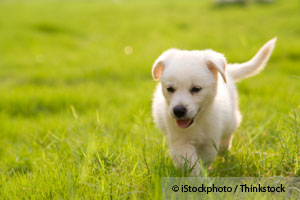Sunday, 19. August 2012 10:29
By Dr. Karen Becker, DVM
 This is the time of year when many dog owners get their pets outside to enjoy the sunshine and lush greenery.
This is the time of year when many dog owners get their pets outside to enjoy the sunshine and lush greenery.
But according to a study published earlier in the year in the journal Environmental Research, a romp across the lawn might actually be dangerous to your pet’s health.
The study, conducted over a six year period at the Foster Hospital for Small Animals at Tufts University’s Cummings School of Veterinary Medicine, showed that exposure to lawn pesticides – specifically those applied by professional lawn care companies – raised the risk of canine malignant lymphoma (CML) by as much as 70 percent.
According to The Merck Veterinary Manual:
Canine malignant lymphoma is a progressive, fatal disease caused by the malignant clonal expansion of lymphoid cells. Although lymphoid cell neoplastic transformation is not restricted to specific anatomic compartments, lymphoma most commonly arises from organized lymphoid tissues including the bone marrow, thymus, lymph nodes, and spleen. In addition to these primary and secondary lymphoid organs, common extranodal sites include the skin, eye, CNS, testis, and bone. Lymphoma is reported to be the most common hematopoietic neoplasm in dogs, with an incidence reported to approach 0.1% in susceptible, older dogs. Despite the prevalence of malignant lymphoma, its etiology remains poorly characterized. Hypothesized etiologies include retroviral infection, environmental contamination with phenoxyacetic acid herbicides, magnetic field exposure, chromosomal abnormalities, and immune dysfunction.
Dogs at Risk for Canine Malignant Lymphoma
From the published study, dogs at highest risk for acquiring CML were:
The study collected data using a 10-page questionnaire mailed to owners whose dogs were patients at Foster Hospital. Unfortunately, the study results do not name the lawn care or pesticide products used, or specific chemical ingredients in the products. It also doesn’t address quantities of chemicals used or length of exposure.
Also absent from the study was mention of genetic factors that might impact which dogs acquire CML. The study dogs were only identified as purebred or mixed breed, with no consideration given to the fact that certain breeds are at increased risk for developing CML. Those breeds include the Airedale, Basset hound, boxer, bulldog, bullmastiff, golden retriever, and the Saint Bernard.
Dogs and Thick Green Lawns
Whereas people have the choice to stay off chemically-treated grass, your dog doesn’t have that option – nor does she have the capacity to understand the potential dangers of rolling around in herbicide and pesticide residue.
People usually wear clothes and shoes outside – dogs don’t. And unlike people, dogs don’t change their fur or foot pads every day and throw the dirty stuff in the washing machine. So whatever collects on their feet and fur outdoors stays there until the next time they get a bath.
Most dogs, given the opportunity to play on thick green grass, will not only run across it, they’ll roll on it, dig around in it, sniff at it endlessly — even snack on it. So it’s easy to envision how normal canine behavior turns risky when your dog’s outdoor environment has been doused in potentially toxic chemicals.
Playing It Safe
Given the Foster Hospital study results, I would certainly recommend dog owners not allow their pets to be exposed to chemical lawn treatments. Specifically:
- Don’t apply pesticides to your yard, and if you use a lawn care service, don’t allow them to use them, either.
- Avoid lawn care and other gardening products that contain insect growth regulators (IGRs). (And be aware that the chemical pyriproxyfen, an IGR, is used in certain flea/tick spot-on treatments.)
- Don’t allow your dog access to any lawn unless you can confirm no pesticides have been used.
If you think your pet has rolled around on chemically treated grass, my recommendation is to bathe him as soon as possible. If you’ve walked your dog in a suspect grassy area, giving him a foot soak as soon as you get home should flush away any chemical residue that may be clinging to his feet and lower legs.
没有评论:
发表评论